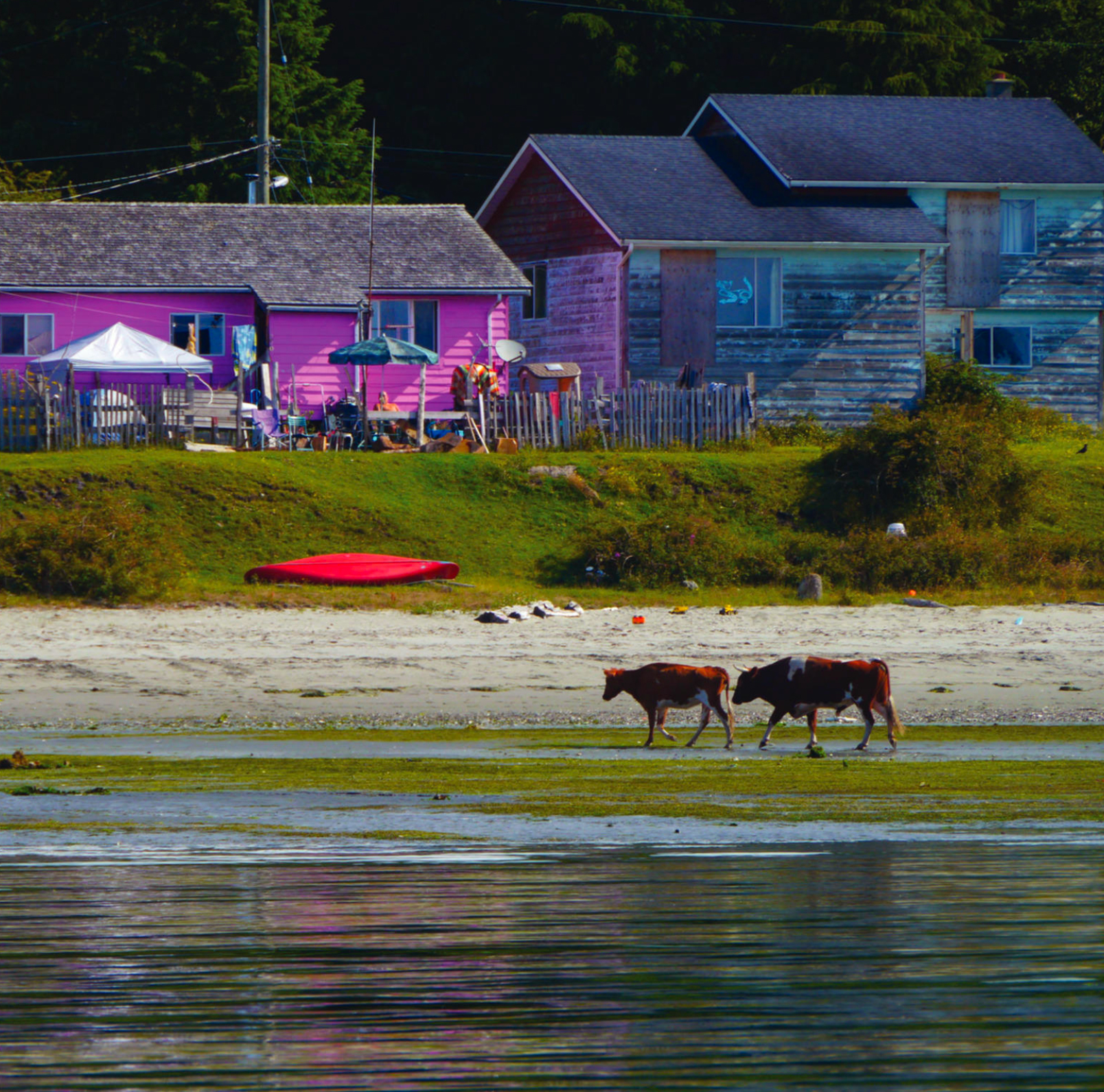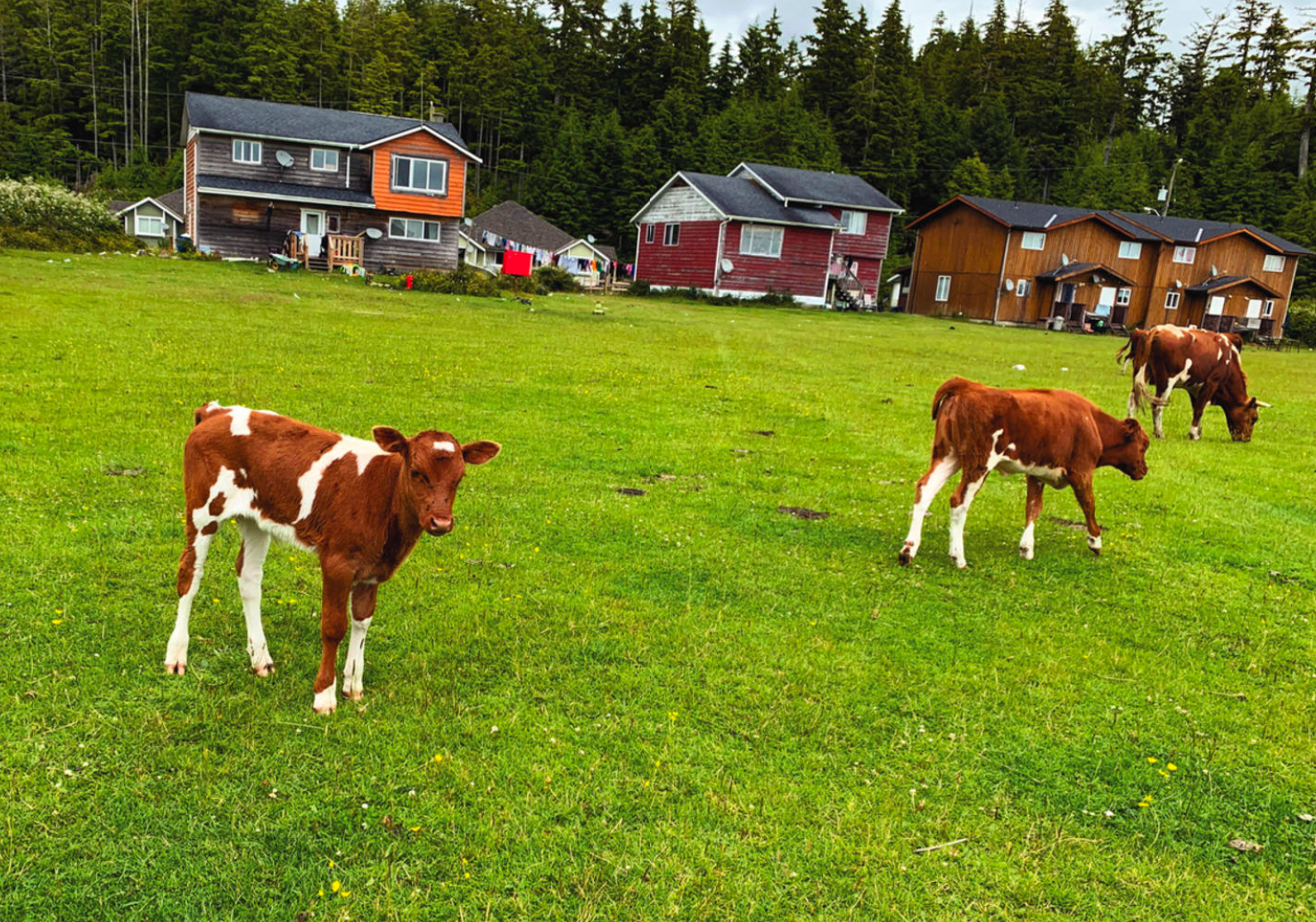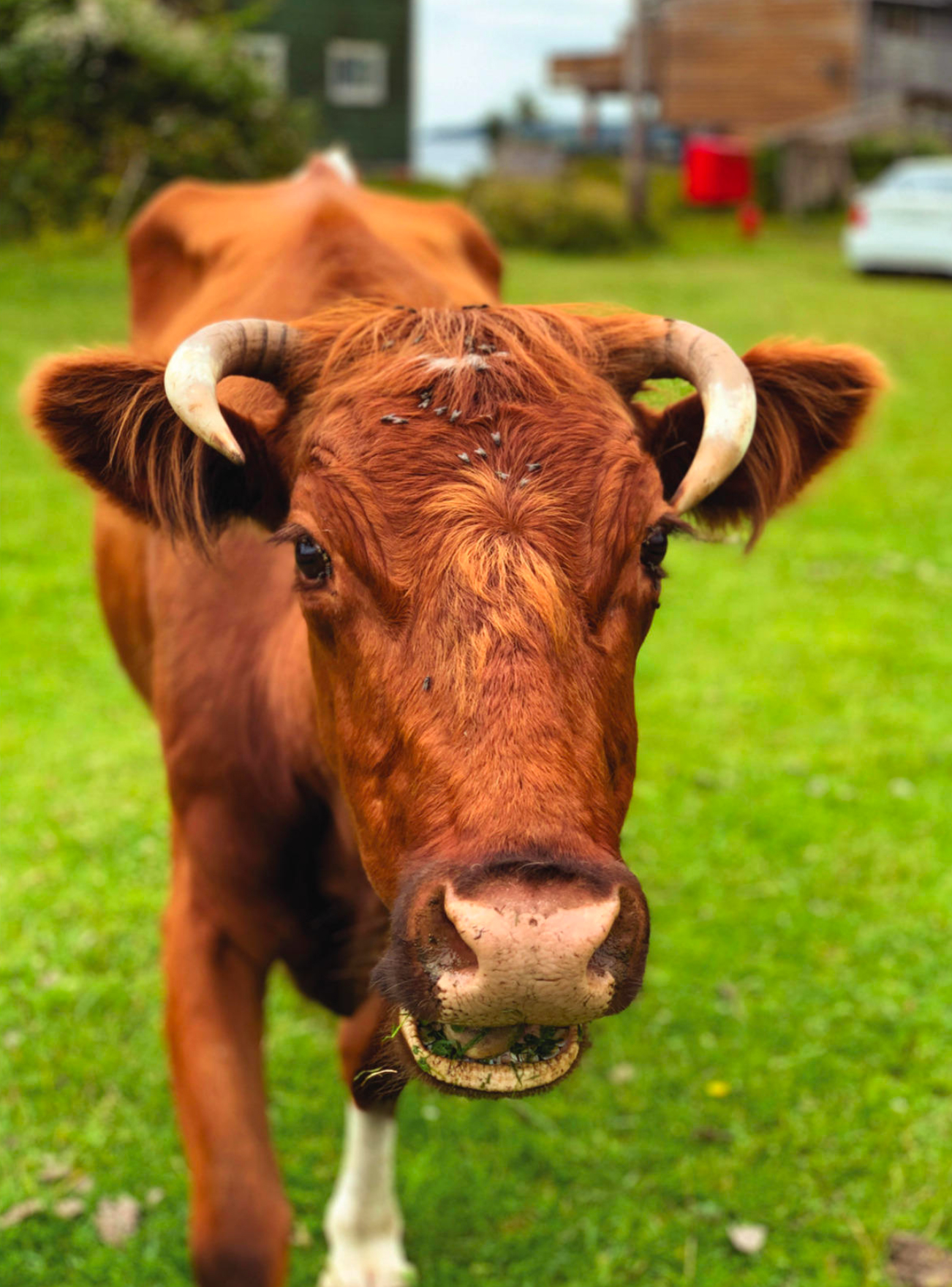“Tourists kayaking or whale watching from Tofino think the cows on Opitsaht are water buffaloes, but they are really more like our pets,” says Moses Martin, laughing. If it’s low tide, look between the brightly painted wooden houses and the ocean. If you see brown and white patches moving along the beach, those are the wild cows of Opitsaht.

Missionaries brought cattle to Opitsaht in the early 1900s in a futile attempt to turn West Coast First Nations fishers into farmers (why would you give up a diet of salmon and seafood right on your doorstep year-round?). They did, however, manage to leave behind a strange legacy.
Moses Martin, chief of Tla-o-qui-aht First Nation, was born and raised in Opitsaht, a tiny village on Meares Island off the west coast of Vancouver Island. Since the 1940s he remembers there were always a dozen or so cows, “but nobody did anything with them and we still pretty much leave them alone except once in a while we will have a potlatch and the Ha’wiih [hereditary chiefs] would allow a cow to be taken. We always had a big stew because there were so many people to feed.”
About once a year, Joe Martin (Moses’ nephew) and his brother will follow a bull into the woods and ambush him. “One shot square in the head right between the eyes,” says Joe. “We wait until October or November when there is frost on the ground so we can hang it in a tree for a week or so. Then we divide it amongst the villagers: everything gets eaten. But most people aren’t interested in killing cows. They prefer to get their meat from the Tofino Co-op or McDonald’s.”
Joe says a favourite pastime growing up in Opitsaht was chasing cows through the bush and catching them by the tail. “One time my friend climbed up a tree and when a big bull plowed underneath he jumped on its back. He fell and broke his collarbone—harmless fun. Another time we chased a big bull down a muddy trail. One guy grabbed his tail but the bull kicked his hoof backwards and left a mud imprint on his face. That kick could have killed him,” Joe chuckles. You have to be tough growing up in these parts. The kids also learned to fish—another reason they weren’t interested in beef.
“Be careful, some of these females are being followed by bulls,” says Joe’s friend Randy Frank as I try for a close-up photo on the community lawn, which is surrounded by houses and dogs. (Here the grass is cropped short like a golf course thanks to the cows keeping it trimmed and fertilized. And they are caretakers at the village cemetery—no need for lawnmowers.) “We have about five bulls now. When one female goes into heat they all fight,” says Frank. “Gotta get out of the way when they run, and do it quickly too.” And I’m warned they can smell strangers, so I don’t wait for a sniff—I hightailed it back to Randy and Joe.
When the tide is out the herd mosey down to the shore and munch on eelgrass, an aquatic plant with long and slender green leaves that grows in the intertidal zone and is more closely related to land-based plants than to the seaweed that grows around it. Seems like eelgrass is their dish of choice. Moses says one winter they had lots of snow and some cows were looking skinny, so people brought bales of hay from Port Alberni. But the cows weren’t interested in eating any, they just slept on it.
According to the Journal of Archaeology in the Low Countries (May 2009), cows enjoy eelgrass once they acquire the taste and walk into the sea to obtain it. Scottish farmers used it as fodder and in western Norway eelgrass was fed to cattle, sheep and horses in winter. When dried, farmers cooked it into a swill, or mixed it with other fodder to make it more attractive to their livestock.

“A Texas rancher who came here fishing said they are unique with their straight backs. He wanted to buy them,” says Frank. “We have no idea what a cow is worth but I heard that the Maasai in Africa gives up 10 cows for a wife.”
There has been some talk of trading bulls (there are currently six, about 13 to 14 years old) for other breeds and maybe trading calves with the herds on Haida Gwaii. Frank remembers other breeds here, black cows, but now they all look the same. There is some concern about inbreeding but they all appear to be healtlhy—could it be their diet?
About the same time the missionaries populated Opitsaht with cows, the Hudson’s Bay Company introduced cattle to Haida Gwaii. The publication Canadian Cattlemen in September 1951 reported that milk cows were sent for the benefit of the miners but the project was abandoned when coal was found in Nanaimo for a much lower cost. In 1901, the cattle were turned loose to fend for themselves and joined other cows that had wandered into the forests and swamps years earlier and had “completely reverted to a wild state.” They were mainly the dual-purpose shorthorn type—suitable for both dairy and beef.
Next up, a settler, intending to sell fresh beef to logging camps, brought herefords to the islands. But it was too expensive and he left them to roam free. Eventually the herefords joined forces with the shorthorns. Another importer brought jerseys but the miners preferred evaporated milk. William” Mexican Tom” Thomas made the last attempt at cash cows in the early 1900s but he lacked a market.
Once they were “wild,” the Haida Gwaii bovines weren’t considered much good for milk or beef. According to Canadian Cattlemen, “They are smaller than jerseys, partly a result of inbreeding and partly the result of their peculiar feeding habits. They have developed long legs, heavy shoulders and lean bodies—they look like a young buffalo without the hump. They are incredibly fleet of foot and said to be able to outrun a deer for a short distance.
Mostly the animals stay in the gently sloping forests but once in a while they wander down to the shore and eat the salty seaweed [eelgrass?]… A wild cow is sometimes shot by a fisherman who fancies a change of meat, but as a rule the animals are left to themselves. It isn’t safe to get close to a cow and downright dangerous to get within sight of a bull. Allan Jessup, a writer for The Province, once spent part of a holiday high up on a spruce tree where he had scrambled to escape the attention of a wild bull.
There were upwards of 1,000 head on Graham Island in 1933. Herds around Skidegate were estimated at 100 in 1950.”

These days, about 16 cows call Opitsaht home, give or take. Nature takes its course: calves are born, some cows die of old age, wolves and cougars take some. Back in early 2008, the herd only had one bull after wolves had taken the other, older male. Cattle experts around Canada and the US were asked how to save the herd but they didn’t have much advice—none were experienced with wild cows. Then, almost miraculously, two calves, male and female, were born in the spring. “We were so relieved. Even though nobody owns them or takes care of them, nobody wanted to see them disappear, either,” says Moses.
More worrisome than cougars and wolves, which are rarely predators, are the village dogs that will often chase and try to nip at the cows. When the herd has had enough harassment, they act like proper cows and meander off somewhere for a while. The dogs don’t hurt them but a few cows have lost their tails, either to the dogs or wolves. Joe says they usually wander across Meares Island to the old Christie Indian Residential School (where he was sent from age seven to 14), which is now a healing centre, “until they feel better about themselves and return. I guess if it works for humans it works for cows too,” he says, laughing again.
If a wander doesn’t do the trick, or if a stray dog won’t stop bothering the cows, a resident often calls CARE Network, a non-profit, volunteer-based animal welfare organization with a mandate to protect and enhance companion animals’ quality of life in rural and remote communities on Vancouver Island’s west coast.
“When a cow is spooked they are agile and move fast. They can jump through the bush and easily knock over an elder, child or even an adult,” says James Rodgers, executive director. “At this point it’s a public safety issue so we will go to Opitsaht and work with families and their dogs, and follow up to make sure the canines aren’t free-roaming.” (During my visit all the dogs were chained up, mostly on back porches. Joe tells me a few dogs have gone flying, so they’ll never chase cows again.)
Medical attention is more complicated. Recently, a cow named Rosie had a horn curving and growing into her skull. Rodgers and his crew came armed with oranges and carrots and grapes to distract the curious herd and keep them at arms’ length to get a closer look at Rosie. A large animal veterinarian was called.
CARE Network keeps an eye on the herd’s wellbeing but the community decides its management and population: births, deaths and the occasional slaughter. And Opitsaht bylaws are more progressive than neighbouring Tofino. “Opitsaht has set a standard in terms of care. Other municipalities have outdated animal bylaws that address control, not necessarily care,” says Rodgers.
As for the future of the herd, CARE Network and Opitsaht community members are talking about building a self-serve structure, like a barn with an open door. “We would stand a better chance if a cow gets sick, as they will be more relaxed in a safe space and treatment will be easier,” says Rodgers. “That decision is up to the Opistaht council.”
I think Opitsaht is a cow’s heaven on Earth, even without a roof over their heads.
Opitsaht
Cows are a very recent addition to Opitsaht. The Tla-o-qui-aht First Nation has called Opitsaht home for more than 5,000 years, making it the oldest continuously occupied village in all of British Columbia. Only about 175 people (at last census in 2006) now live in Opitsaht, along with 16 cows, a far cry from a village that once boasted over 200 monumental longhouses, with one house belonging to Chief Wickaninnish large enough to house 1,000 people.

